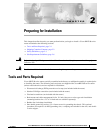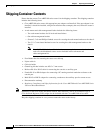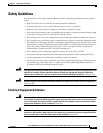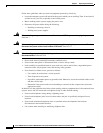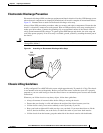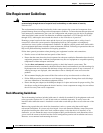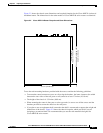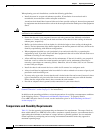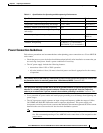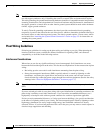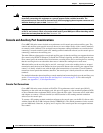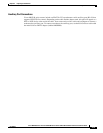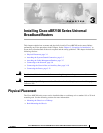
2-8
Cisco uBR7100 Series and Cisco uBR7100E Series Universal Broadband Router Hardware Installation Guide
OL-5916-01
Chapter 2 Preparing for Installation
Site Requirement Guidelines
When planning your rack installation, consider the following guidelines:
• Install the router in an open rack whenever possible. If installation in an enclosed rack is
unavoidable, ensure that the rack has adequate ventilation.
An enclosed rack should have louvered sides and a fan to provide cooling air, because heat generated
by equipment near the bottom of the rack can be drawn upward into the intake ports of the equipment
above.
Caution To prevent chassis overheating, never install the router in an enclosed rack or room that is not properly
ventilated or air conditioned.
• Ensure that the rack is not congested, because each unit generates heat. Maintain a minimum
clearance of 3 inches (7.62 cm) on the back and front of the chassis for the cooling air inlet and
exhaust ports, respectively.
• Baffles can isolate exhaust air from intake air, which also helps to draw cooling air through the
chassis. The best placement of the baffles depends on the airflow patterns in the rack, which can be
found by experimenting with different configurations.
• When equipment installed in a rack (particularly in an enclosed rack) fails, try operating the
equipment by itself, if possible. Power off other equipment in the rack to allow the unit under test a
maximum of cooling air and clean power.
• Allow sufficient clearance around the rack for maintenance. If the rack is mobile, you can push it
back near a wall or cabinet for normal operation and pull it out for maintenance (installing or
removing a port adapter or connecting cables). Otherwise, allow 19 inches (48.3 cm) of clearance
to remove the port adapter.
• Install the chassis and external devices to which it will connect in a contiguous stack.
• Always install heavier equipment in the lower half of a rack to maintain a low center of gravity and
prevent the rack from falling over.
• If you use telco-type racks, be sure that the rack is bolted to the floor and secured, because in these
types of installations only one end of the chassis mounts to the two rack posts with the brackets.
Ensure that the weight of the chassis does not make the rack unstable.
• Provide an adequate chassis ground (earth) connection for your router chassis.
Note We strongly recommend that you provide a chassis ground connection. (See “Attaching the System
Ground Connection” section on page 3-5 for instructions.)
In addition to the preceding guidelines, review the precautions for avoiding overtemperature conditions
in the following section, “Temperature and Humidity Requirements.” To properly install a
Cisco uBR7100 series chassis in a rack, see the instructions given in “Rack-Mounting the Chassis”
section on page 3-3.
Temperature and Humidity Requirements
Table 2-1 lists the operating and nonoperating environmental site requirements. The ranges listed are
those within which Cisco uBR7100 series routers continue to operate; however, a measurement that is
approaching the minimum or maximum of a range indicates a potential problem. You can maintain
normal operation by anticipating and correcting environmental anomalies before they approach a
maximum operating range.




